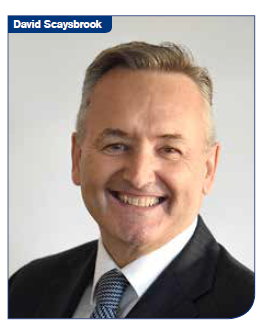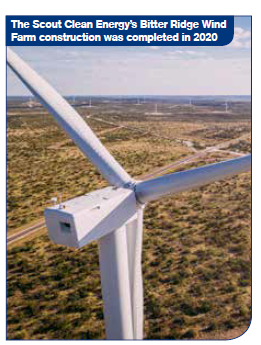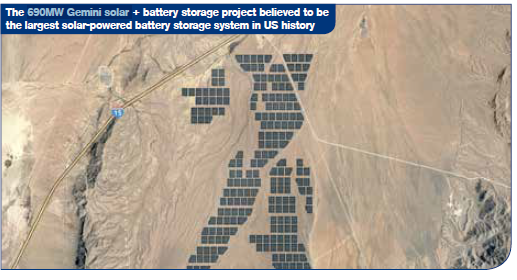The Quinbrook Interview
Quinbrook has built a reputation for staying ahead of the curve in energy transition, making moves before others and positioning itself in newer markets, capturing that essential first-mover advantage.
It’s hard to keep doing that consistently but that’s the challenge Quinbrook has set itself – to become a leader in areas that are relevant to its mission of cheaper renewables, decarbonisation and driving Net Zero.
It is for this reason that Quinbrook was selected for the IJGlobal Awards 2020 Investor of the Year by an independent panel of judges. As one judge said: “Given the current emphasis on green energy, net zero carbon footprint, and environmental stewardship, Quinbrook’s engagement in the sector makes them the clear frontrunner in this category this year.”
- This interview first appeared in IJGlobal Magazine, to access click here...
Other judges said Quinbrook had an “impressive portfolio of innovative green energy and data projects, demonstrating leadership in what can only be significant growth areas” and showed “clear and concise examples of sustainable investments”.
And one judge said that due to its investments in new infrastructure assets: “Quinbrook delivered direct and measurable ESG impact across job creation, preservation and training, carbon emissions reduction, environmental improvement, local community financial and social benefits.
Quinbrook’s diverse portfolio of cutting-edge technology investments puts it at the forefront of the accelerating energy transition to achieve ‘Net Zero’ emissions from the US energy supply system.”
Quinbrook’s win was based on 3 key investments, a green data centre joint venture plus a record breaking solar and battery storage project, and a large scale wind platform built from a startup.
The specialist investor formed a joint venture (Rowan) with Birch Infrastructure to develop and commission new ‘powered land’ solutions for mission critical, hyperscale data centres that take advantage of low-cost renewable power.

“We aren’t data centre experts, but we are highly experienced in development-led renewable power solutions and felt we were qualified - if we could find the right partner - to go after this particular customer segment undergoing huge growth in power demand. In Birch we found a partner – who was very sympatico with us - halfway down this path. They brought their data centre experience and we brought our renewable energy experience. This is indicative of our future direction in developing and supplying innovative and low cost zero carbon power solutions to energy intensive customers.”
Green data centres is a new thematic for Quinbrook. It is the first transaction in the area, setting the foundations for what it believes will be many more investments to come. There are over 20 sites in the joint venture portfolio pipeline already and Quinbrook and Birch are actively working on 3 additional data centre projects in advanced negotiations, one in Australia and 2 in the US.
“We are branching out into not only enterprise and high-performance computing but also dedicated block chain data centres, another high growth subsector we are increasingly interested in,” says Scaysbrook.
Quinbrook launched Primergy Solar in 2020 to acquire, develop and operate solar PV and battery storage projects in North America with the $1.1 billion capex, 690MW Gemini solar + battery storage project believed to be the largest solar-powered battery storage system in US history.
By historic standards, Quinbrook’s Primergy Solar went through the permitting process far faster than expected by taking advantage of a Trump initiative called Fast 41. This law requires all federal agencies to consider new project applications in 12 months. So what could take 3-4 years actually got done in less than half the time. Scaysbrook said: “We didn’t realise at the time that we were negotiating the biggest solar project in US history!”
The Gemini project is also using a DC coupled system which uses an electrical configuration designed to add more efficiency and is one of the first DC-coupled solar battery storage systems of its size in the US.
A third standout deal for Quinbrook was Glidepath Power Solutions, a start-up business that it acquired in 2017. At the time, Quinbrook was looking for a team that had expertise in battery storage which was a growing sector but still very nascent and risky.
Fast-forward to 2020, Glidepath has grown to a portfolio spread over 19 US states and a near $5 billion potential capital investment pipeline of battery storage projects.
In February 2020, Glidepath announced that it would complete development and achieve construction readiness on one of the largest portfolios of standalone battery storage projects to date in New York State after receiving an incentive award from the New York State Energy Research and Development authority (NYSERDA).
The portfolio consists of 4 X 20MW battery storage projects which would more than double New York state’s current storage capacity, providing a cleaner, more efficient and lower-cost alternative to the fossil fuel plants that presently provide peaking power and ancillary services.
Quinbrook’s 2020 goals and looking ahead: “In 2020, most if not all of the goals we set for the year were achieved,” says Scaysbrook.
Those goals included:
- fully allocating the Low Carbon Power Fund by the end of 2020
- getting the UK flexible power portfolio to scale and hitting the 300MW target size threshold
- diversifying into a new sector: management of flexible power assets and demand response in the UK by acquiring Flexitricity towards the end of 2020
- completing construction of Scout Clean Energy’s Bitter Ridge Wind Farm in Indiana
- securing final US Government approvals for the Gemini Solar+ Storage project in Nevada
- merging the Energy Locals and Energy Trade distributed energy businesses in Australia and hitting the 50,000 contracted customer connections target

“We want to take our experience in the coupling of solar and battery storage and help energy-intensive industry to decarbonise through the supply of low cost renewable power,” says Scaysbrook.
“Another key area that we want to enhance our expertise in is the application of digital and advanced data analytical technologies to better differentiate our projects and boost the value of our infrastructure assets. This is where we will focus on the application of machine learning and artificial intelligence to optimise the dispatch and management of our assets. This is where we think the market is heading and is consistent with our role as a ‘hands on’ active asset manager”.
Quinbrook is also looking at green fuels and green hydrogen production – both areas that it is monitoring closely because they are areas that it feels will grow and mature in different countries at different times. “Australia and certain states in the US that have a strong endowment of renewable energy resource could become the epicentres of cheap power and we believe this is where new green industry will be built”.
“Australia is naturally endowed with a competitive advantage to be an exporter of products and commodities that can be manufactured or processed with low carbon impact by using cheap renewables.
It has cheap and vast land mass, abundant solar, wind and transport logistics enabling the competitive manufacture of green hydrogen, metals, ammonia and other green transport fuels. This changes the landscape and explains why we do certain things in certain places and not others and who our customers are or are likely to be”.
“In 2020 90% of all new power capacity added on the planet was renewable so the next question is: what do we do with all that cheap clean power? We want to substitute and electrify industries that are still using fossil fuels, that is where Quinbrook is heading,” says Scaysbrook.
Scaysbrook explains that hydrogen is much like aluminium, with a lot of electricity effectively embedded in the end product so the bigger energy intensive projects will gravitate to those locations that can produce it the most cheaply: “Texas and Australia have enduring competitive advantage so these places will likely become preferred host locations for the large scale manufacturing of green hydrogen as just one example. Green hydrogen is an industry that will be like a bushfire, once it starts it will rage!”
Regionally, Quinbrook tends to stick to countries and markets it knows well – UK, Australia and North America – and has no current plans to venture outside of those territories.
Scaysbrook says: “According to EY, the US, UK and Australia are 3 of the top 5 to invest in renewable energy globally and we are already operating at scale in each of them. It’s a big decarbonisation challenge in each of those 3 markets over the many decades to come. These countries are so opportunity rich that we don’t really need to go off frontiering.”
Given that Quinbrook has just 20 investment professionals globally, it certainly gets a lot done! “We haven’t missed a beat because of COVID-19 given the continuing velocity of our work, and in fact our workload has likely doubled in intensity” says Scaysbrook.
“We want to continue to move into smarter areas of the market offering better returns before our competition, we aren’t interested in doing the biggest deals for the sake of it although we’ll continue to do benchmark transactions or precedent-setting deals if they make sense - it’s really about staying ahead of the curve and trying always to be the best investor we can be for our clients.”
Request a Demo
Interested in IJGlobal? Request a demo to discuss a trial with a member of our team. Talk to the team to explore the value of our asset and transaction databases, our market-leading news, league tables and much more.
